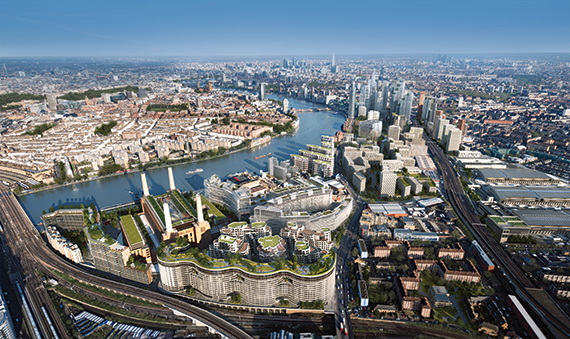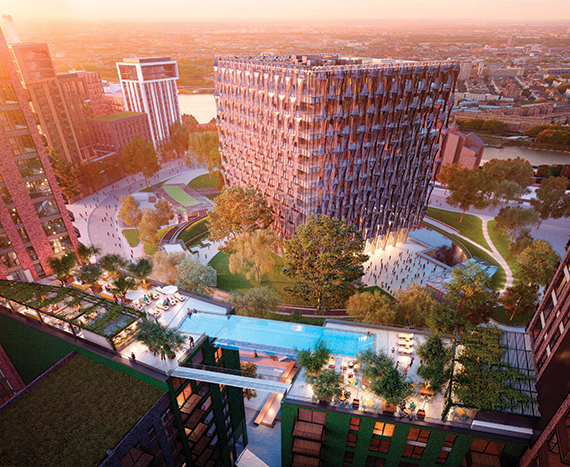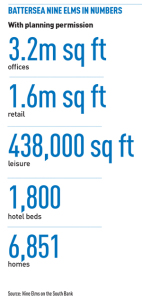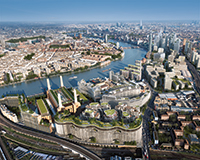 Looking out to the Battersea Nine Elms regeneration area, the sky is punctuated by cranes as far as the eye can see; a symbol of the neighbourhood’s dramatic ongoing transformation from industrial site to a vibrant commercial and residential district – or at least that is the aim.
Looking out to the Battersea Nine Elms regeneration area, the sky is punctuated by cranes as far as the eye can see; a symbol of the neighbourhood’s dramatic ongoing transformation from industrial site to a vibrant commercial and residential district – or at least that is the aim.
But how do you turn the steel-capped boots into suits or, more likely, iPads and skinny jeans?
The 227ha regeneration zone is the largest in London. The 35 planned schemes could create 20,000 homes, of which 4,000 will be affordable, and 6m sq ft of commercial space – 3.1m sq ft of which will be offices (see graphic).
On paper, it seems like an easy sell for office occupiers. Two new Tube stations (Nine Elms and Battersea) on a new spur of the Northern Line will link the area with the West End and City and new homes, shops, bars and restaurants should help create a vibrant district.
However, there are challenges along the way, not least existing connectivity – the Tube line extension is not due to complete until 2020.
Ravi Govindia, leader of Wandsworth Council, is, unsurprisingly, enthusiastic. “From Vauxhall you can get to Oxford Street; there are the main lines taking you into Bank – one shouldn’t wait around for the Northern Line extension to happen in order to relocate,” he says.
But in practice, getting around is more complex. There is a courtesy bus service from Vauxhall to Battersea Power Station for site workers – “Making the commute easier for our contractors”, as it says on its side – which highlights the problem.
Vauxhall, at the northern end of the regeneration site, has a Tube station, mainline rail station and a bus station, but it is a 20-minute walk to Battersea, which at present is served only by mainline services to Victoria and Waterloo from two separate stations.
In 2017, the US and Dutch Embassies will open, together with new public space, as part of Embassy Gardens. The Ballymore scheme also includes a 100-bedroom hotel and 500,000 sq ft of office space, as well as shops and restaurants. The development will be served by the Nine Elms Tube station, but in the interim it is within easy walking distance of Vauxhall.
Vauxhall has several new residential and mixed-use towers under construction or in planning, and a number of established businesses including Cap Gemini and the Big Issue. Most recently The Office Group has submitted plans for Tintagel House in Vauxhall, SE1, which it wants to refurbish into its largest London office at 106,000 sq ft.
 The area also has a number of restaurants, such as Dirty Burger and Nando’s, and an established nightlife scene, with several clubs under the railway arches. But the power station at the other end of the regeneration zone is pretty much starting from scratch.
The area also has a number of restaurants, such as Dirty Burger and Nando’s, and an established nightlife scene, with several clubs under the railway arches. But the power station at the other end of the regeneration zone is pretty much starting from scratch.
The first offices won’t complete until the new Tube stations are due to open, but what happens in the meantime as the housing and other commercial elements come on stream?
Sean Ellis, chairman of St James, which is developing Riverlight (see panel) says phasing is important: “If it were all residential, it would become a dormitory. You need a mix of uses and space and it needs to be attractive day and night.”
David Twohig, chief development officer at Battersea Power Station Development Company, says: “We are long-term investors, so it isn’t just about leasing a building and leaving the next day, it is about building a community over years.”
Work began on the power station in 2013, after it was bought by a consortium of Malaysian investors comprising SP Setia, Sime Darby and the Employees’ Provident Fund, and BPSDC is managing the development. It will include flats, offices, retail and leisure space.
Designed by architects Wilkinson Eyre, the office space at the power station is being marketed largely as a hub for media and tech HQs, with exposed brickwork and large floorplates. Agents say the offices are also being pitched as a natural extension of the South Bank and the West End, but with significantly cheaper rents (see below).
There is talk of deals – ITV and Apple are names that regularly crop up in market gossip – but if either, or indeed anyone, has signed on the dotted line, it is being kept quiet. To get such a big name would be a positive statement.
A raft of prelets has also reportedly been signed in the retail units, but again names are not forthcoming. The first phase of development, comprising residential and retail, completes in 2017.
Confidence and enthusiasm is one thing, but success can only be measured in deals. And as yet, it is early days.

Past masters
The obvious comparison for Battersea Nine Elms is Canary Wharf. Both schemes envisioned the transformation of industrial land into a vibrant commercial and residential district, with improved transport links.
But where Canary Wharf had the benefit of one landowner, Battersea Nine Elms is a crowded party of more than 15 developers, two local authorities, Transport for London, the Greater London Authority, and more.
Mark McAlister, consultant at Carter Jonas and ex-partner at CBRE, acted as the leasing agent for Canary Wharf from 1992 to 1999, when the scheme was at the same stage as Battersea Nine Elms is now.
He says that while big occupiers are looking at fringe locations positively, the options of walking from Battersea Park station or taking a bus from Vauxhall are “unfeasible” from a tenant perspective.
“If you want the Canary parallels, it’s quite simple – we struggled until people believed the Jubilee Line was actually being built. Without that credibility, we had no chance,” he says.
“They just have to be patient. People don’t believe things until they see them.”
Resi trend moves in one direction
Some 20,000 homes are planned as part of the Battersea Nine Elms regeneration. Of these, some 5,800 are under construction or in planning. By the end of 2016, 3,100 homes (360 affordable) are expected to be complete.
Key sites marked for redevelopment include New Covent Garden Market and Royal Mail’s Vauxhall site, which has planning consent for almost 2,000 homes.
But the residential development has already been subject to controversy over the number of investors buying off-plan and how many of the apartments will actually be lived in.
The early developments have sold well. Sean Ellis, chairman of St James, says 90% of the company’s 700-home Riverlight scheme has sold. The area has celebrity endorsement, too, with One Direction’s Harry Styles and television personality Bear Grylls reported to have bought property.
Most of the cranes across the regeneration site are for residential-led schemes, but land sales on remaining sites have slowed. For example, the Royal Mail site near Embassy Gardens remains on the market after almost a year.
There have also been fears that international investors holding second homes and those unable to make a profit on resales could spark an increase in vacant property.
Mark McAlister, consultant at Carter Jonas, says: “I’d be very worried that half the lights on all those prelets don’t go on. The high-cost ones are going to be ghost towns.”
Where there was a healthy off-plan take-up, factors such as the tumbling price of oil and economic instability in China and Russia could mean international buyers start to dry up.
GL Hearn’s Giula Bunting says: “The challenge is that if ultimately massive amounts of flats are delivered in a relatively short time, could it maybe lead to oversupply?”
David Twohig of BPSDC says 70% of sales at the power station are to British-based buyers. “None of the 1,500 purchasers have withdrawn.”
Rent advantage
Battersea Nine Elms will have a key advantage over other office locations: competitive rents.
Understood to be in the region of £50 per sq ft and up, floorspace at Battersea Power Station is considerably cheaper than the West End and South Bank.
Knight Frank forecasts core West End headline rents to reach £117 per sq ft this year, while Victoria and South Bank come in at £80 per sq ft and £70 per sq ft, respectively.











